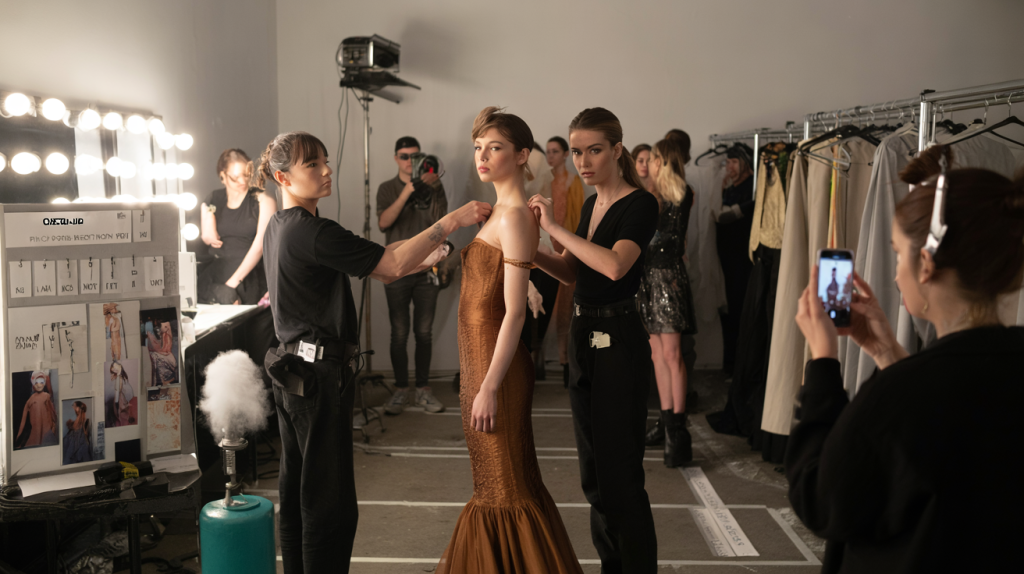The lights hit for 10 minutes, but the real show starts hours earlier, in a maze of garment racks, cords, steam and adrenaline. Backstage moves fast, sometimes too fast to breath, and every second counts. Miss one fitting pin or a model cue and the whole runway rhythm shudders.
Fashion weeks set the pace twice a year in New York, London, Milan and Paris. The system has history and rules. The Council of Fashion Designers of America notes New York Fashion Week began in 1943, created to spotlight American design during wartime. Since then, a modern runway slot still runs short and sharp – The New York Times has chronicled shows that clock about 10 minutes while hundreds of looks, beauty choices and tech cues collide behind the curtain.
Backstage at Fashion Week: the moving parts no one sees
Here is the core dynamic. A collection lands, the casting locks, and a venue turns into a micro city. Hair, makeup, dressers, sound, light, photographers, PR, security and runners share the same few meters. Every role carries a clock. Models rotate chairs, fittings finalize the walk, and the run-of-show board becomes the law.
Pressure peaks as the audience lines up outside. A look has to read from 15 meters away, under hot light, through three cameras. A stylist’s last-minute tweak – a belt notch, a cuff, a pin – can save a silhouette. One misstep can slow an entire sequence. This is why call times start hours earlier for big shows, so the team can rehearse patterns and flag risks before the first beat drops.
Timing, teams and call sheets: how a runway really runs
Show length stays short on purpose. Editors need pace, buyers need clarity, and cameras need uninterrupted movement. That 10-minute format, widely reported by The New York Times in fashion coverage across the 2010s, compresses everything. It forces exact timing in beauty, dressing and model flow.
Calendars still shape the industry backbone. The CFDA traces NYFW to 1943, then globalized with Paris and Milan building their own official schedules in the decades that followed. Two main seasons each year keep the grind steady. The result: teams plan for months to deliver minutes.
Tech now anchors timing. Wireless headsets, shared spreadsheets and a stage manager’s cues thread the room together. When a cue shifts by 30 seconds, makeup speeds up, dressers pre-open zips, and the lineup adjusts. Energy rises, but the best teams keep voices low and hands steady.
Mistakes that blow up backstage – and how pros avoid them
The usual culprits exist. Over-fitted looks that cannot exit quickly. Shoes not broken in. Jewelry that snags. Hair pieces that lift under heat. Spilled foundation on pale fabrics. Noise near the lineup door that rattles a first-time walker.
Solutions sound simple because they are habits, not hacks. Teams stage test-walks in full look. Dressers pre-snap and pre-clip. Beauty chiefs set a single reference face chart for every chair. Runners clear the pathways and tape floors with visual cues. A good stage manager calls time out loud at fixed intervals so everyone breathes in sync.
Backstage gear also matters, more than most imagine.
- Industrial steamer and a lint roller for every rail
- Double-sided tape and tiny safety pins near the lineup
- Neutral makeup remover and microfiber cloths for emergency stains
- Extra insoles, heel grips and skin-tone bandages for shoe fit
- Portable phone chargers and a shared clock set to showtime
A small detail saves minutes. Minutes save shows. That chain stays true across cities and seasons, no matter the budget or venue size.
From catwalk to phone screen: social media runs the afterburn
Backstage moved online. Instagram launched in 2010 and reported more than 2 billion monthly users in 2023, according to Meta. TikTok announced 1 billion monthly users in September 2021. Those numbers changed how a runway lives after the last look exits. A single backstage clip can travel faster than a front-row review.
So teams now protect the reveal while fueling reach. PR sets no-post zones near unreleased looks. Creators shoot approved moments – hair textures, fabric swish, model lineup – without spoiling the finale. Lighting rigs add a small neutral corner for clean phone footage. This balance gets negotiated in advance, written into call sheets, and checked again during lineup.
A straightforward blueprint keeps all of this together. One master run-of-show with exact times, a model board that shows hair and makeup per look, and a final checkpoint five minutes before first walk. Add a quick-reset table near the exit for clips, pins and wipes, so the second exit stays as clean as the first. It sounds basic, definitly, but it is the missing piece when chaos tries to win.
When pressure climbs, the fix is always the same. Clear the lanes, read the clock, and hold the reveal until the music lifts. Backstage isn’t mystery. It is sequencing – and strong sequencing makes those 10 minutes land like a story.
